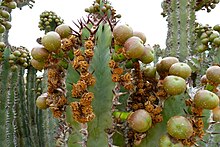Euphorbia virosa
| Euphorbia virosa | ||||||||||||
|---|---|---|---|---|---|---|---|---|---|---|---|---|

Fully grown Euphorbia virosa near Solitaire on the edge of the Namib-Naukluft Park |
||||||||||||
| Systematics | ||||||||||||
|
||||||||||||
| Scientific name | ||||||||||||
| Euphorbia virosa | ||||||||||||
| Willd. |
The Namibian poison wolf milk ( Euphorbia virosa ) is a species from the genus Euphorbia within the family of the milkweed family (Euphorbiaceae).
description
It is a tree-like, thorny succulent that grows up to 150 cm in height and can do without water for up to four years. Typical of the succulents with a maximum height of 30 cm are the four to five-sided branches that radiate out from it. The yellow flowers sit on the edges of the branch ends.
Others
The plant contains a milky, creamy, almost latex-like substance with carcinogenic properties in the branches and fruit capsules and is considered to be one of the most poisonous plants in the world. This is why the San ( Bushmen ) use them to dip the tips of their arrows in them before hunting. Contact with the substance causes skin irritation and blindness may occur if the eyes are affected.
Only oryx and rhinos can digest the poison of the succulent plant, and the rhinos even need the poison to break down food.
Occurrence
The occurrence of Euphorbia virosa extends from the Orange River in South Africa to southern Angola , Lesotho and Swaziland . The plants are protected under the Washington Convention on the Protection of Species .
Origin of names and taxonomy
Euphorbia virosa is called Gifboom (poison tree) in Afrikaans and was first published and named by Carl Ludwig von Willdenow in 1799 .
Individual evidence
- Christoper Brickell (Editor-in-chief): RHS AZ Encyclopedia of Garden Plants . Third edition. Dorling Kindersley, London 2003, ISBN 0-7513-3738-2 . (engl.)
